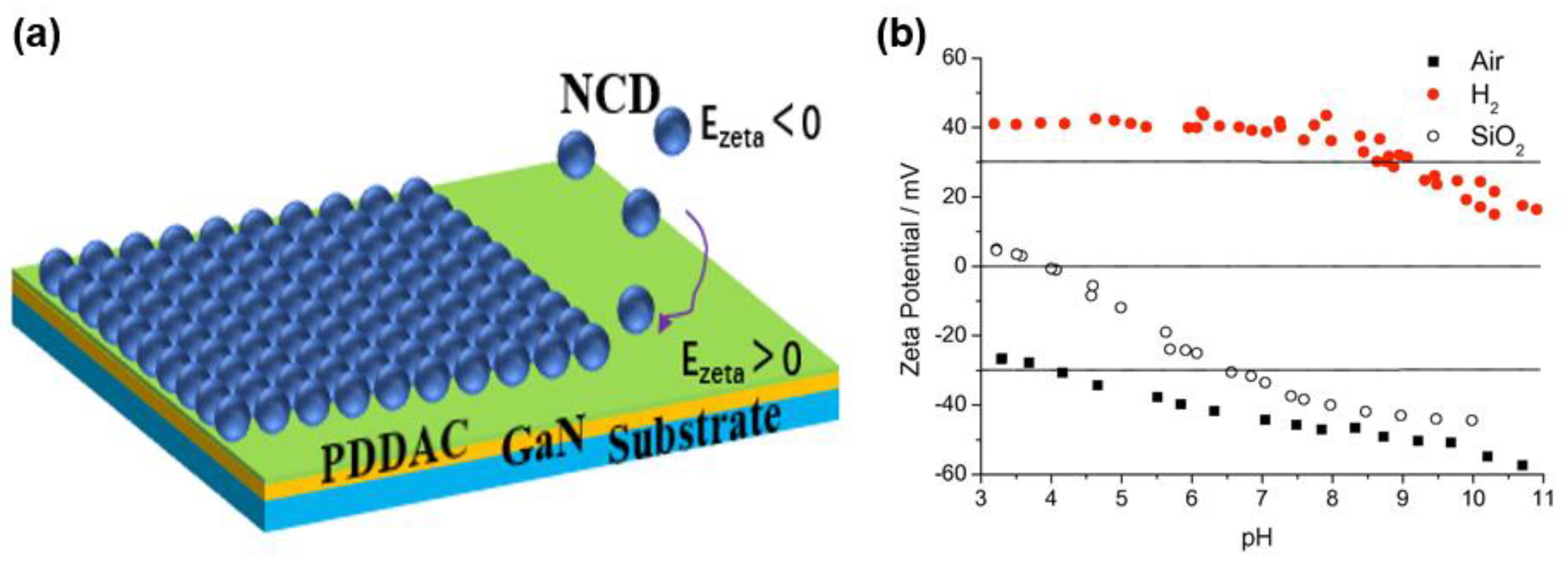Nucleation is a key process for the growth of diamond films. Spontaneously nucleation on heterogeneous substrates is difficult. This is mainly because the high surface energy of diamond. Rapid nucleation (a few minutes commonly) is a necessary condition for the deposition of high-quality diamond films. The characteristics of the substrate, such as surface defects, surface energy, surface diffusion and bulk diffusion of atoms, and chemical reactivity, affect the diamond nucleation process. Especially, a gallium nitride (GaN) substrate, which has a large lattice mismatch and thermal expansion mismatch with diamond, puts forward some difficult requirements for diamond nucleation. The temperature of the substrate also affects the diamond nucleation process. Considering the quality and rate of diamond nucleation and the thermal stability of GaN high electron mobility transistors (HEMTs), researchers regard ~600 °C as a more suitable nucleation temperature.
- diamond
- GaN HEMTs
- thermal management
1. Nucleation through Ultrasonic Particle Treatment
2. Bias Enhanced Nucleation
3. Electrostatic Seeding


References
- Spitsyn, B.V.; Bouilov, L.L.; Derjaguin, B.V. Vapor growth of diamond on diamond and other surfaces. J. Cryst. Growth 1981, 52, 219–226.
- Schweitz, K.O.; Schou-Jensen, R.B.; Eskildsen, S.S. Ultrasonic pre-treatment for enhanced diamond nucleation. Diam. Relat. Mater. 1996, 5, 206–210.
- Mohapatra, D.R.; Rai, P.; Misra, A.; Tyagi, P.K.; Yadav, B.S.; Misra, D.S. Parameter window of diamond growth on GaN films by microwave plasma chemical vapor deposition. Diam. Relat. Mater. 2008, 17, 1775–1779.
- Mandal, S. Nucleation of diamond films on heterogeneous substrates: A review. RSC Adv. 2021, 11, 10159–10182.
- Yugo, S.; Kanai, T.; Kimura, T.; Muto, T. Generation of diamond nuclei by electric field in plasma chemical vapor deposition. Appl. Phys. Lett. 1991, 58, 1036–1038.
- Lifshitz, Y.; Köhler, T.; Frauenheim, T.; Guzmann, I.; Hoffman, A.; Zhang, R.Q.; Zhou, X.T.; Lee, S.T. The Mechanism of Diamond Nucleation from Energetic Species. Science 2002, 297, 1531–1533.
- Oba, M.; Sugino, T. Oriented growth of diamond on (0001) surface of hexagonal GaN. Diam. Relat. Mater. 2001, 10, 1343–1346.
- Alomari, M.; Dipalo, M.; Rossi, S.; Diforte-Poisson, M.A.; Delage, S.; Carlin, J.F.; Grandjean, N.; Gaquiere, C.; Toth, L.; Pecz, B.; et al. Diamond overgrown InAlN/GaN HEMT. Diam. Relat. Mater. 2011, 20, 604–608.
- Kohn, E.; Alomari, M.; Gao, Z.; Rossi, S.; Dussaigne, A.; Carlin, J.-F.; Grandjean, N.; Aretouli, K.E.; Adikimenakis, A.; Konstantinidis, G.; et al. Direct Interpretation of Diamond Heat Spreader with GaN-Based HEMT Device Structures. In Proceedings of the High Performance Devices. Lester Eastman Conference (LEC), Ithaca, NY, USA, 5–7 August 2014; pp. 1–4.
- Williams, O.A.; Douhéret, O.; Daenen, M.; Haenen, K.; Ōsawa, E.; Takahashi, M. Enhanced diamond nucleation on monodispersed nanocrystalline diamond. Chem. Phys. Lett. 2007, 445, 255–258.
- Girard, H.A.; Perruchas, S.; Gesset, C.; Chaigneau, M.; Vieille, L.; Arnault, J.C.; Bergonzo, P.; Boilot, J.P.; Gacoin, T. Electrostatic grafting of diamond nanoparticles: A versatile route to nanocrystalline diamond thin films. ACS Appl. Mater. Interfaces 2009, 1, 2738–2746.
- Hees, J.; Kriele, A.; Williams, O.A. Electrostatic self-assembly of diamond nanoparticles. Chem. Phys. Lett. 2011, 509, 12–15.
- Babchenko, O.; Dzuba, J.; Lalinský, T.; Vojs, M.; Vincze, A.; Ižák, T.; Vanko, G. Stability of AlGaN/GaN heterostructures after hydrogen plasma treatment. Appl. Surf. Sci. 2017, 395, 92–97.
- Wiese, G.R.; Healy, T.W. Effect of particle size on colloid stability. R. Soc. Chem. 1970, 66, 490–499.
- Williams, O.A.; Hees, J.; Dieker, C.; Jäger, W.; Kirste, L.; Nebel, C.E. Size-Dependent Reactivity of Diamond Nanoparticles. ACS Nano 2010, 4, 4824–4830.
- Gines, L.; Mandal, S.; Morgan, D.J.; Lewis, R.; Davies, P.R.; Borri, P.; Morley, G.W.; Williams, O.A. Production of Metal-Free Diamond Nanoparticles. ACS Omega 2018, 3, 16099–16104.
- Ozawa, M.; Inaguma, M.; Takahashi, M.; Kataoka, F.; Krüger, A.; Ōsawa, E. Preparation and Behavior of Brownish, Clear Nanodiamond Colloids. Adv. Mater. 2007, 19, 1201–1206.
- Stehlik, S.; Varga, M.; Stenclova, P.; Ondic, L.; Ledinsky, M.; Pangrac, J.; Vanek, O.; Lipov, J.; Kromka, A.; Rezek, B. Ultrathin Nanocrystalline Diamond Films with Silicon Vacancy Color Centers via Seeding by 2 nm Detonation Nanodiamonds. ACS Appl. Mater. Interfaces 2017, 9, 38842–38853.
- Mandal, S.; Thomas, E.L.H.; Middleton, C.; Gines, L.; Griffiths, J.T.; Kappers, M.J.; Oliver, R.A.; Wallis, D.J.; Goff, L.E.; Lynch, S.A.; et al. Surface Zeta Potential and Diamond Seeding on Gallium Nitride Films. ACS Omega 2017, 2, 7275–7280.
- Girard, H.A.; Scorsone, E.; Saada, S.; Gesset, C.; Arnault, J.C.; Perruchas, S.; Rousseau, L.; David, S.; Pichot, V.; Spitzer, D.; et al. Electrostatic grafting of diamond nanoparticles towards 3D diamond nanostructures. Diam. Relat. Mater. 2012, 23, 83–87.
- Santos, M.; Campos, R.A.; Azevedo, A.F.; Baldan, M.R.; Ferreira, N.G. Nanocrystalline Diamond Films Prepared with Different Diamond Seeding Processes of 4 Nm and 0.25 Μm Diamond Powders. Mater. Sci. Forum 2014, 802, 146–151.
- Domonkos, M.; Ižák, T.; Kromka, A.; Varga, M. Polymer-based nucleation for chemical vapour deposition of diamond. J. Appl. Polym. Sci. 2016, 133, 43688.
- Scorsone, E.; Saada, S.; Arnault, J.C.; Bergonzo, P. Enhanced control of diamond nanoparticle seeding using a polymer matrix. J. Appl. Phys. 2009, 106, 014908.
- Kromka, A.; Babchenko, O.; Potocky, S.; Rezek, B.; Sveshnikov, A.; Demo, P.; Izak, T.; Varga, M. Diamond nucleation and seeding techniques for tissue regeneration. Diam. -Based Mater. Biomed. Appl. 2013, 206–255.
- Izak, T.; Babchenko, O.; Jirásek, V.; Vanko, G.; Vallo, M.; Vojs, M.; Kromka, A. Selective area deposition of diamond films on AlGaN/GaN heterostructures. Phys. Status Solidi B 2014, 251, 2574–2580.
- Das, D.; Singh, R.N. A review of nucleation, growth and low temperature synthesis of diamond thin films. Int. Mater. Rev. 2007, 52, 29–64.
- Zhang, W.; Xia, Y.; Shi, W.; Wang, L.; Fang, Z. Effect of substrate temperature on the selective deposition of diamond films. Diam. Relat. Mater. 2000, 9, 1687–1690.
- Larijani, M.M.; Navinrooz, A.; Le Normand, F. The bias-assisted HF CVD nucleation of diamond: Investigations on the substrate temperature and the filaments location. Thin Solid Film 2006, 501, 206–210.
- Silva, W.M.; Ferreira, N.G.; Travello, J.; Almeida, E.C.; Azevedo, A.F.; Baldan, M.R. Dependence of diamond nucleation and growth through graphite etching at different temperatures. Diam. Relat. Mater. 2007, 16, 1705–1710.
